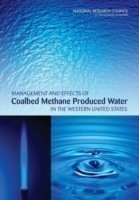In some coalbeds, naturally occurring water pressure holds methane—the main component of natural gas—fixed to coal surfaces and within the coal. In a coalbed methane (CBM) well, pumping water from the coalbeds lowers this pressure, facilitating the release of methane from the coal for extraction and use as an energy source. Water pumped from coalbeds during this process—CBM 'produced water'—is managed through some combination of treatment, disposal, storage, or use, subject to compliance with federal and state regulations.
CBM produced water management can be challenging for regulatory agencies, CBM well operators, water treatment companies, policy makers, landowners, and the public because of differences in the quality and quantity of produced water; available infrastructure; costs to treat, store, and transport produced water; and states' legal consideration of water and produced water. Some states consider produced water as waste, whereas others consider it a beneficial byproduct of methane production. Thus, although current technologies allow CBM produced water to be treated to any desired water quality, the majority of CBM produced water is presently being disposed of at least cost rather than put to beneficial use.
This book specifically examines the Powder River, San Juan, Raton, Piceance, and Uinta CBM basins in the states of Montana, Wyoming, Colorado, New Mexico, and Utah. The conclusions and recommendations identify gaps in data and information, potential beneficial uses of CBM produced water and associated costs, and challenges in the existing regulatory framework.
Table of Contents
- Front Matter
- Summary
- 1 Methane and Water in Coalbeds
- 2 Coalbed Methane Produced Water in Western U.S. Basins: Hydrogeological and Geochemical Foundations
- 3 Regulatory Context for Coalbed Methane Produced Water Management
- 4 Coalbed Methane Produced Water Management and Beneficial Uses
- 5 Environmental Effects of Coalbed Methane Development and Produced Water Management
- 6 Technologies and Costs for Coalbed Methane Produced Water Treatment
- 7 Conclusions and Recommendations
- Appendixes
- Appendix A: Legislative Authorization Language H.R. 6 - Energy Policy Act of 2005 Section 1811. Coal Bed Methane Study
- Appendix B: Committee and Staff Biographical Sketches
- Appendix C: Presentations to the Committee
- Appendix D: Information Inventory
- Appendix E: Historical Significance of a Water "Compact": Development of the Colorado Compact and the Upper Colorado River Basin Compact
- Appendix F: Tribal Management of Coalbed Methane Development and Produced Water
- Appendix G: Acronyms and Abbreviations

















